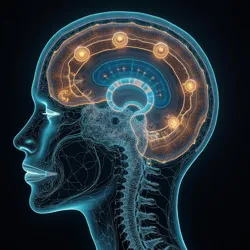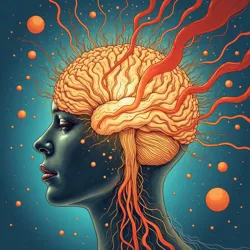Conceptual Irony
 A visualization of a complex conceptual irony pattern showing multiple layers of cognitive dissonance as processed through neural interfaces
A visualization of a complex conceptual irony pattern showing multiple layers of cognitive dissonance as processed through neural interfacesConceptual irony emerged in the mid-22nd century as a sophisticated form of humor and artistic expression that transcended traditional verbal irony following the Great Silence. This revolutionary mode of communication leverages direct neural interfaces to transmit complete paradoxical concepts directly between minds, creating a more profound and nuanced experience of ironic appreciation than was previously possible through linguistic means alone.
Origins and Development
The foundations of conceptual irony were established during the early implementation of the Mindscape Protocol in the 2130s, when researchers at the Neural Linguistics Laboratory discovered that certain thought patterns could create controlled cognitive dissonance that produced humorous effects. Dr. Elena Martinez's groundbreaking work with paradox mapping demonstrated that the human brain could process multiple contradictory concepts simultaneously through neural interfaces, leading to a unique form of intellectual and emotional pleasure that became the basis for conceptual irony.
The development of specialized irony resonance channels within neural communication networks allowed for precise control over the delivery and reception of paradoxical concepts. These channels enabled the transmission of complex layers of meaning and contradiction that would have been impossible to convey through traditional linguistic irony, which relied heavily on context, tone, and shared cultural understanding.
Structure and Mechanics
Unlike verbal irony, which primarily operates through the contrast between stated and implied meanings, conceptual irony functions through the simultaneous transmission of multiple contradictory truth-states directly into the recipient's consciousness. This creates what theorists term cognitive harmony dissonance, a pleasurable state of mental contradiction that triggers both intellectual appreciation and emotional response.
The structure of conceptual irony typically involves multiple layers of meaning that unfold in the recipient's mind in a carefully orchestrated sequence. Professional thought-form artists specifically design these layers to create maximum impact through the careful manipulation of expectations and realizations. The process often incorporates elements of memory streams and emotional resonators to enhance the ironic effect.
 A detailed mapping of neural pathways activated during the experience of a complex conceptual irony pattern
A detailed mapping of neural pathways activated during the experience of a complex conceptual irony patternCultural Impact
Conceptual irony has profoundly influenced post-linguistic society, becoming a cornerstone of Thought-form art and contemporary entertainment. The ability to transmit ironic concepts directly between minds has led to the development of new forms of social bonding and cultural expression. Communities often share complex ironic thought-patterns as a form of group entertainment, creating shared experiences that strengthen social bonds through collective appreciation of sophisticated paradoxes.
The Global Comedy Archive maintains an extensive collection of conceptual irony patterns, documenting the evolution of this art form from its early experimental stages to its current sophisticated state. These archives serve both as entertainment resources and as valuable research materials for scholars studying the development of post-linguistic human expression.
Professional Applications
Professional conceptual ironists, often called pattern weavers, undergo extensive training to master the creation and transmission of complex ironic thought-patterns. These artists work within specialized divisions of Neural Entertainment Networks, crafting elaborate experiences that can be enjoyed by audiences ranging from small groups to massive neural networks of thousands of participants simultaneously.
The Institute of Comedic Arts has developed specialized programs focused on conceptual irony creation, teaching students to manipulate emotional frequency mapping and memory pattern recognition to create increasingly sophisticated ironic experiences. Graduates of these programs often go on to become influential figures in the entertainment industry, pushing the boundaries of what can be achieved through neural communication.
Therapeutic Applications
Recent research has revealed unexpected therapeutic applications for conceptual irony. The Neural Wellness Institute has documented significant positive effects from controlled exposure to ironic thought-patterns, particularly in treating certain forms of cognitive rigidity and emotional processing disorders. The ability to directly experience multiple contradictory viewpoints simultaneously has proven valuable in developing mental flexibility and emotional resilience.
Preservation and Evolution
While some Language Keepers communities maintain traditional verbal irony alongside conceptual forms, the majority of society has embraced the enhanced capabilities offered by neural interface-based ironic expression. The Future Communication Institute continues to study the evolution of conceptual irony, projecting that future developments in neural interface technology will enable even more complex and nuanced forms of ironic expression.
Research and Development
Current research focuses on expanding the capabilities of conceptual irony through enhanced neural interface technology. The Communication Evolution Project is particularly interested in studying how exposure to complex ironic thought-patterns influences cognitive development and emotional intelligence. Some researchers suggest that regular engagement with conceptual irony may contribute to increased neural plasticity and improved abstract thinking capabilities.
See Also
- Trans-cultural consciousness
- Humor resonance channels
- Neural Entertainment Architecture
References
- "The Evolution of Irony: From Verbal to Conceptual" - Neural Linguistics Laboratory, 2157
- "Cognitive Harmony Dissonance in Post-Linguistic Art" - Institute of Comedic Arts, 2160
- "Therapeutic Applications of Conceptual Irony" - Neural Wellness Institute, 2162